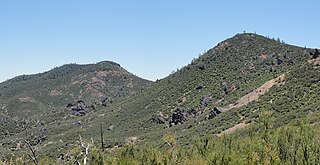
Chalone identifies the first American Viticultural Area (AVA) established in Monterey County, California straddling its border with San Benito County where it is the second established AVA. Chalone viticultural area is located in the Gabilan Mountains east of Soledad. It was recognized by the Bureau of Alcohol, Tobacco and Firearms (ATF) effective on July 14, 1982 after reviewing the petition submitted by the Gavilan Vineyards, Inc. to establish a viticultural area in Monterey and San Benito counties to be named "The Pinnacles." The area encompasses 8,640 acres (14 sq mi) and the proposed name was recognition of the nearby Chalone peaks.

Horse Heaven Hills is an American Viticultural Area (AVA) in southeastern Washington lying in portions of Klickitat, Yakima, and Benton counties, north and west of the Columbia River and south of the Yakima Valley and lies within the vast Columbia Valley appellation. Horse Heaven Hills was established by the Alcohol and Tobacco Tax and Trade Bureau {TTB), Treasury on June 30, 2005 after reviewing the petition filed by Paul D. Lucas on behalf of regional wine grape growers. Horse Heaven Hills viticultural area is about 60 miles (97 km) long and 22 miles (35 km) wide located 115 miles (185 km) east from Vancouver, Washington. The appellation encompasses 570,000 acres (891 sq mi) with about 6,400 acres (2,590 ha) under vine.

Napa Valley is an American Viticultural Area (AVA) located in Napa County, California. It was established by the Bureau of Alcohol, Tobacco and Firearms (ATF) on January 27, 1981. Napa Valley is considered one of the premier wine regions in the world. Records of commercial wine production in the region date back to the nineteenth century, but premium wine production dates back only to the 1960s.
Knights Valley AVA is an American Viticultural Area (AVA) in Sonoma County, California. One of Sonoma County's original five AVAs, Knights Valley AVA was formally designated an American Viticultural Area on October 21, 1983. Knights Valley AVA includes approximately 37,000 acres (150 km2). Over 30 growers maintain the 2,000 acres (8 km2) planted to wine grape vineyards. The easternmost designated Sonoma County wine region, Knights Valley AVA has the warmest climate in the county. The valley lies between the Alexander Valley AVA and Chalk Hill AVA wine regions to the west and the Mayacamas Mountains to the east. Geographically, the appellation separates the rest of Sonoma County from the Napa Valley AVA.

Santa Maria Valley is an American Viticultural Area (AVA) which straddles the boundary of Santa Barbara and San Luis Obispo counties in California's multi-county Central Coast AVA. It was established on August 5, 1981, by the Bureau of Alcohol, Tobacco, Firearms and Explosives (ATF) as California's second oldest AVA. A portion of the AVA crosses the Cuyama River into the southernmost corner of San Luis Obispo County. The east–west orientation of the 152.3 square miles with a wide, open valley and rolling hills means cool winds and fog flow in freely from the Pacific Ocean, settling most noticeably in lower-lying areas. The result is a mild Mediterranean climate that lengthens the growing season and contributes to the eventual sugar/acid balance in the grapes from Santa Maria Valley's 7,500 acres (3,000 ha) cultivated vineyards. On January 28, 2011, the AVA was granted an 29.4 square miles expansion to its southern boundary.

The Suisun Valley AVA is an American Viticultural Area in Solano County, California, located just east of the Napa Valley wine region in the Coast Range. It was established as a wine appellation on 27 December 1982.

Snake River Valley is Idaho’s first American Viticultural Area (AVA) that encompasses an area in southwestern Idaho and two counties in eastern Oregon. The area was established on April 9, 2007 by the Alcohol and Tobacco Tax and Trade Bureau (TTB), Treasury after reviewing the petition submitted by Idahoan vintners of the Snake River Valley, the Idaho Grape Growers and Wine Producers Commission, and the Idaho Department of Commerce and Labor, collectively acting as “petitioner” to establish the 8,263 square miles viticultural area named "Snake River Valley." For wines to bear the "Snake River Valley" label, at least 85% of the grapes used for production must be grown in the designated area, which includes the southwestern Idaho counties of Ada, Adams, Boise, Canyon, Elmore, Gem, Gooding, Jerome, Owyhee, Payette, Twin Falls, and Washington, and the Eastern Oregon counties of Malheur and Baker. The appellation, when established, was resident to 15 wineries and 46 vineyards with 1,800 acres (728 ha) under vine.

Sonoma County wine is wine made in Sonoma County, California, in the United States.
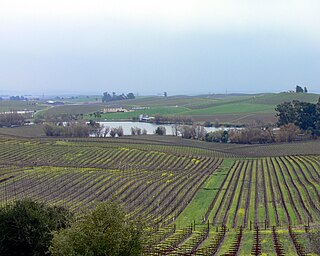
Los Carneros AVA is an American Viticultural Area which includes parts of both Sonoma and Napa counties in California, U.S.A. It is located north of San Pablo Bay. The proximity to the cool fog and breezes from the bay makes the climate in Los Carneros cooler and more moderate than the wine regions farther north in Napa Valley and Sonoma Valley. The cooler climate has made Los Carneros attractive for the cultivation of cooler climate varietals like Pinot noir and Chardonnay. Many of the grapes grown in Los Carneros are used for sparkling wine production. Receiving its AVA status in 1983, the Carneros area was the first wine region in California to be defined by its climate characteristics rather than political boundaries.

The Atlas Peak AVA is an American Viticultural Area located within Napa Valley AVA just northeast of the city of Napa. The appellation sits on a higher elevation than most of Napa's wine region which limits the effects of the cool fog coming in from Pacific Ocean. The westward orientation of most vineyards on the Vaca Mountains also extends the amount of direct sunlight on the grapes. The soil of this AVA is volcanic and very porous which allows it to cool down quickly despite the increased sunlight. The area has a fairly significant diurnal temperature variation upwards of 30 °F (17 °C) between daytime and night. This contributes to the balance of acidity that grapes from Atlas Peak vineyards are known to have.

The Stags Leap District AVA is an American Viticultural Area located within the Napa Valley AVA 6 miles (9.7 km) north of the city of Napa, California. The Stags Leap District was the first appellation to be designated an AVA based on the unique terroir characteristics of its soil. The soil of this region include loam and clay sediments from the Napa River and volcanic soil deposits left over from erosion of the Vaca Mountains. Like many Napa Valley AVAs, Stags Leap District is particularly known for its Cabernet Sauvignon. In 1976 at the Judgment of Paris wine tasting, the 1973 Stag's Leap Wine Cellars Cabernet from the area that would become this AVA won first place in the red wine category, beating out classified Bordeaux estates. Today, the Stags Leap District is home to twenty different wineries.
The Chiles Valley is an American Viticultural Area (AVA) located in Napa County, California and a sub-region within Napa Valley AVA. It was established as California's 81st AVA by the Bureau of Alcohol, Tobacco and Firearms (ATF) on April 19, 1999 after the ATF received the petition from Mr. Volker Eisele, owner of the Volker Eisele Vineyard and Winery proposing a new viticultural area in Napa County to be known as "Chiles Valley District".

The Spring Mountain District AVA is an American Viticultural Area located in the Napa Valley AVA in California. Spring Mountain District AVA was officially established as an American Viticulture Area in 1993. Encompassed within its bounds are about 8,600 acres (3,480 ha), of which about 1,000 acres (400 ha) are planted to vineyards. Given the small crop yields on hillsides, the region represents less than 2% of Napa Valley wine. Currently the region has just over 30 winegrowers.

El Dorado is an American Viticultural Area (AVA) located in El Dorado County, California, east of the state’s capital, Sacramento and centered around the county seat of Placerville. It was established on November 14, 1983 by the Bureau of Alcohol, Tobacco, Firearms and Explosives (ATF), Treasury after approving the submitted petition from the El Dorado Wine Grape Growers Association of Camino, California applying to establish a viticultural area named "El Dorado.” The area includes parts of El Dorado County on the north border by the Middle Fork American River and on the south by the South Fork of the Cosumnes River. El Dorado viticultural area lies within the vast 4,062 square miles Sierra Foothills viticultural area, one of the largest appellations in California, which extends about 170 miles (274 km) through portions of Yuba, Nevada, Placer, El Dorado, Amador, Calaveras, Tuolumne and Mariposa Counties. The El Dorado viticultural area encompasses 1,093,120 acres (1,708 sq mi) which entirely includes Fair Play and a small portion of northeastern California Shenandoah Valley AVAs.
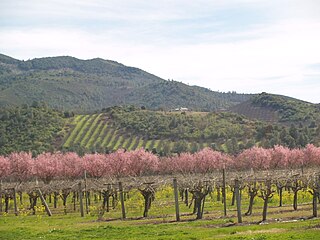
Lake County wine is an appellation that designates wine made from grapes grown mostly in Lake County, California. The region is located north of Napa County and east of Mendocino County. Although each region within Lake County has unique viticultural attributes, many are influenced by Clear Lake, the largest inland body of water in California.
The Pine Mountain-Cloverdale Peak AVA is an American Viticultural Area in Sonoma County. It is located at the top of Pine Mountain, at the Northern end of the Mayacamas Range, which separates the Napa and Sonoma growing regions. The AVA, which rises between 1600 feet at its lowest point to 2600 feet at its highest, is one of the highest grape growing regions in California.
Kelsey Bench-Lake County is an American Viticultural Area located in Lake County, California. The area is home to some 900 acres of vines in 27 vineyards, and was officially established as an AVA by the Alcohol and Tobacco Tax and Trade Bureau (TTB) in October 2013. Sauvignon blanc, Chardonnay, Viognier and Riesling are the principal white grape varieties within Kelsey Bench and its neighbor the Big Valley District AVA. Zinfandel, Merlot and Cabernet Franc varieties make up the majority of red grape plantings in the area.
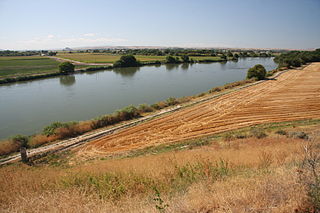
Eagle Foothills is the second American Viticultural Area (AVA) in the state of Idaho located in the southwestern region in Gem and Ada Counties. The area lies southeast of Emmett, north of Eagle and approximately 10 miles (16 km) northwest of the city of Boise. It was established on December 28, 2015 by the Alcohol and Tobacco Tax and Trade Bureau (TTB), Treasury as the first sub-appellation in the vast Snake River Valley viticultural area and the first appellation entirely within Idaho’s state borders. It does not overlap with any existing or proposed AVA. Eagle Foothills lies at the north bank of Ancient Lake Idaho with its elevations ranging from 2,490 to 3,412 feet (759–1,040 m). The area encompasses 49,815 acres (78 sq mi) with nearly 70 acres (28 ha) under vine with plans to add 472 acres (191 ha) and seven vineyards. Its USDA plant hardiness zones are 7a and 7b. Vineyard elevations are below 3,000 feet (914 m). The majority of viticulture activity is at 3 Horse Ranch Vineyards with its 46 acres (19 ha) in center of the appellation. The cool climate and relatively short growing season are suitable for growing early to mid-season varietals such as Chardonnay, Pinot Gris and Riesling.
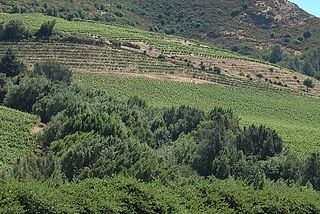
Moon Mountain District Sonoma County is an American Viticultural Area (AVA) within Sonoma Valley and North Coast viticultural areas, just north of the city of Sonoma. This mountainous region on the very eastern edge of Sonoma County has a historic reputation for producing rich, intensely-flavored wines from Cabernet Sauvignon and Syrah varietals since the 1880s. The District was established on November 1, 2013, by the Alcohol and Tobacco Tax and Trade Bureau (TTB). Its designation covers 17,663 acres (28 sq mi) of land stretching north-south along the western slopes of the Mayacamas mountains between Sugarloaf Ridge State Park and Los Carneros viticultural area with the Napa Valley’s Mount Veeder viticultural area outlining the eastern slopes. Its name is derived from Moon Mountain Road, which traverses through the area and itself a reference to Sonoma, which means 'valley of the moon' in the local Native American dialect. A clear view to San Francisco 50 miles (80 km) south is not uncommon from Moon Mountain District vineyards.

Gabilan Mountains is an American Viticultural Area (AVA) located in the mountainous region on the border in Monterey and San Benito Counties in California. It is the tenth and newest AVA established in Monterey County by the Alcohol and Tobacco Tax and Trade Bureau (TTB) on September 14, 2022, becoming the state's 147th official AVA after the TTB reviewed the petition from Parker Allen of Coastview Vineyards, proposing to establish the "Gabilan Mountains" viticultural area. Gabilan Mountains encompasses about 98,000 acres (153 sq mi) including the established Mt. Harlan and Chalone AVAs, and resident to 4 wineries and 6 commercial vineyards cultivating approximately 436 acres (176 ha). The average elevation within the region is 2,370 feet (722 m) placing it above the heavy fog and marine layer. As a result, Gabilan Mountains AVA has a cool air climate without the humidity from the fog and low-lying clouds.















